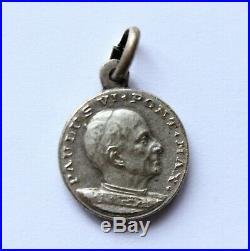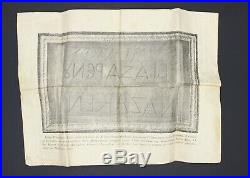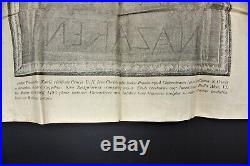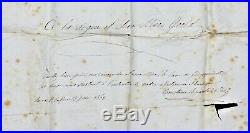













Collection of religious objects and Crhistian Holy relics Inheritance of the Bonaparte Family. A little piece of the history.. 1 -XVIII Century silver double glass reliquary with the Holy Relic of. Father of the Blessed Virgin Mary and Confessor. As written in relic S. Feast day: 26 July. Patron of: Fathers, grandparents. 2 -Document of Authenticity (COA) 1906. Signed by Cardinalis Mathew. This is a very important official ecclesiatical document certificating the authenticity of the. Following relics: Martyrum Alexandri Papae I, Eventii, Theoduli, Sabinae Vid. And Seraphieae Virg , by the Cardinal François-Désiré Mathieu in Rome. 3 -Catholic silvered medal with the venerable image of Pope Paulus VI Pontifex Max and a Earth of the Catacombe Roma relic. Together with the pendant we have a Pope Paulus VIs picture dedicated on the back, as it has the words for you written at the back of the picture. 4 -Holy Facsimile of the Titulus Crucis Relic. The Titulus Crucis is a piece of wood kept in the Church of Santa Croce in Gerusalemme in Rome, which is claimed to be the titulus (title panel) of the True Cross on which Jesus was crucified. Saint Helena, Roman Empress and mother of Emperor Constantine the Great, went on pilgrimage to the Holy Land and reportedly discovered the True Cross and many other relics (such as the sponge and this one) which were donated to the church of Santa Croce in Gerusalemme (“Holy Cross in Jerusalem”) which she had built in Rome about AD 325. The original board is made of walnut wood, and it was supposed to have three inscriptions, one in Hebrew, another one in Greek and the last one in Latin. The first line of the inscription is almost destroyed. The second line is written in Greek letters and reversed script, the third in Latin letters, also with reversed script. The Latin reads Iesus Nazarenus Rex Iudaeorum (“Jesus the Nazarene King of the Jews”), corresponding to the Gospel of John and the initials INRI familiar to pious Catholics. This document we have is a facsimile of the original board, which became a relic itself since it has been put in touch with the original relic board. It is believed that throughout this process the object gets particles of the original relic. Below the inscription there is a text written in latin that says. Imago triumphalis Tituli vivificae Crucis DN Jesu Christi qualis hodie Romae apud Cisterciensen, intra Basilicam S. Crucis in Jerusalem, seu intra Capellam Sum Reliquiarum conspicitur, cujus Tituli Veritatem Atq: Inventionem Bulla Alex: Papae Vi, Dat. Romae that July 29, 1496, plene Testatur; Characteres autem infabre tunc temporis sculptos, ut vides, vetustas paulatim laesit, sed Hebraicos magis. Which translated to English means. Depiction of the glorious title of the life-giving cross of Our Lord Jesus Christ, such as the still today in Rome in the Cistercian Basilica of the Holy Cross in Jerusalem, in the Holy-relic chapel can be seen. The authenticity and recovery of the title has been solemnly confirmed in a bull of Pope Alexander VI, which was issued in Rome on July 29, 1496; the letters are carelessly engraved, as you see; in addition, time has increasingly damaged them, most notably the Hebrew (of which the features at the top are the only remnant). 5 -Letter from Constance Bonaparte. Who was Louis-Lucien Bonapartes sister, addressed to the nun Charlotte Goold, dated from the 13th June 1868. Both nuns belonged to the Congregation of the Sacred Heart, which is a Roman Catholic religious congregation founded in France in 1800 in response to the extreme violence of Revolutionary France. In such a broken society the Society of the Sacred Heart hoped to present the love of God revealed in the Heart of Christ and help the restoration of Christian life in France. Its major work was the education of young women of the rich and the poor classes. Constance Bonaparte was a Clare and Abbess of the Convent of the Sacred Heart of Jesus in Rome, whereas Charlotte Goold was sent to Ireland with the aim to expand the congregation and open a Sacred Heart convent there. 6 -Clipping from a newspaper, titled A princess will. There, it is written that the Princess Clemence Bonaparte (formerly Clemence Richard), who was the spouse of Louis-Lucien Bonaparte, has passed away, leaving her possessions in testament to Sir Isambard Owen and Mrs Laura Elisabeth Brooke. Mrs Laura Elisabeth Brooke had been married to Louis Clavering Clovis Bonaparte, the son of Louis-Lucien Bonaparte & Clemence Bonaparte. Sir Isambard Owen, was a major figure in the creation of the University of Wales and was its Deputy Chancellor from its creation. He was knighted in the 1902 Coronation Honours, receiving the accolade from King Edward VII at Buckingham Palace. Owen was executor of the will of Prince Louis Lucien Bonaparte (18131891) and may have acted as medical advisor to the Prince, who lived in London and was a philologist with an interest in the Celtic languages including Welsh. This interesting collection of religious items are part of the heritage of the Bonaparte family, specifically relatives to Napoleon I. Some of the objects belonged to Constance Bonaparte, who was nice of Napoleon I, and was Abbess of the Convent of the Sacred Heart of Jesus in Rome. When she died in 1876, these belongings were most likely inherited by his brother, Louis-Lucien Bonaparte, who in return left these in hands of his second spouse Clemence Bonaparte, after he died in 1891, making Princess Celemence Bonaparte the safe keeper of these Holy artifacts until her own death in 1914 as stated in the newspaper included in the collection. Below you have the background of the three personalities from the Bonaparte family involved or mentioned in the papers included in the collection. Daughter of Lucien Bonaparte (brother of Napoleon I), niece of Napoleon I as well as cousin of Napoleon III. Born 30 Jan 1823 and death on the 5 Sep 1876. She was a Clare and Abbess of the Convent of the Sacred Heart of Jesus in Rome (Monastero delle Ancelle del Sacro Cuore di Gesu’). Most likely the original owner of the relic present in the collection and the initiator of this religious collection. Born in exile in England, did not visit France until 1848. Although his cousin, Napoleon III, rose to power and made Louis-Lucien a Prince and a Senator, he played no part in politics during the Second Empire, and dedicated his life instead to the study of the basque language and studying English dialects. He spent most of his mature life living in London, together with whom later would become his second spouse, Clemence (Richard) Bonaparte. Princess Celemence Bonaparte. Was the second spouse of Louis-Lucien Bonaparte aforementioned. She was born in 1830 in Soule, the south of France. Very close to the Spanish border. She eventually moved to the Basque country with her family, where she met the Prince Bonaparte, who was there on one of his trips to study the basque language and its different dialects. All relics are in great condition and in their original place inside their thecas. Documents and picture shows signs of wear and tear consistent with its age. It is our sincere intention that a person of faith will take custody of, treasure this sacred artefact, and treat it with due reverence and genuine devotion. At ValiArt Sacred Art & Antiques we take pride in our work by making detailed and accurate description of every item. The item “Reliquaries & Relics Emperor Bonaparte’s family collection of religious objects” is in sale since Friday, May 8, 2020. This item is in the category “Collectibles\Religion & Spirituality\Christianity\Relics”. The seller is “valiart” and is located in Sliema. This item can be shipped worldwide.
- Material: Silver
- Featured Refinements: Reliquary
- Type: Relic
- Age: 1700s – 1900s
- Handmade: Yes
- Modified Item: No
- Country/Region of Manufacture: Italy
- Certificate of Authenticity: Yes
